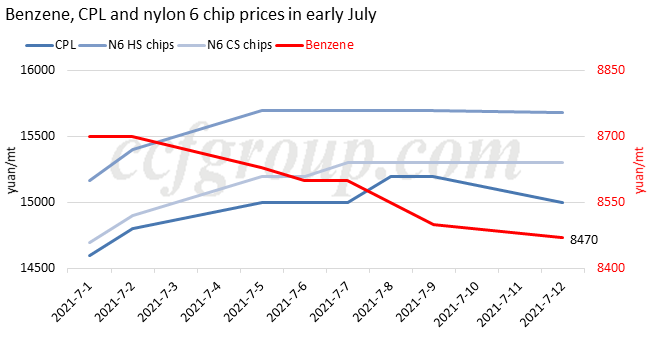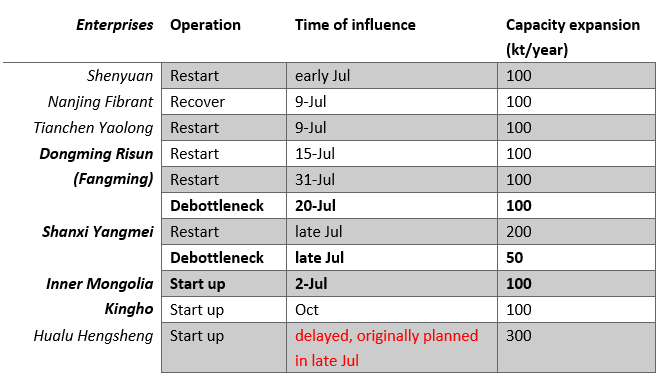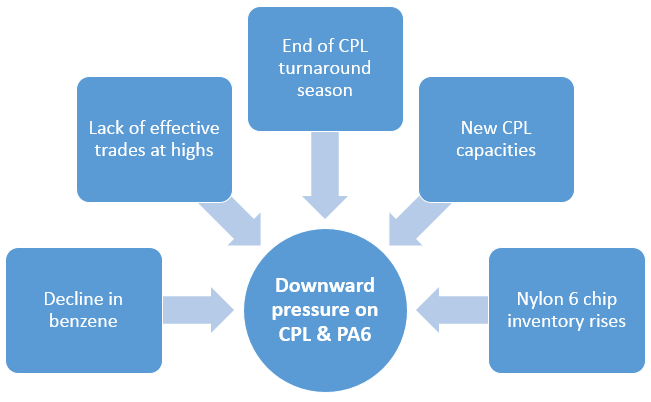CPL & PA6 under downward risks
Benzene triggers decline in CPL

* HS- high-speed spinning, CS- conventional spinning
Since the beginning of July 2021, benzene market, the key intermediate to make caprolactam and nylon 6 polymer, was on a downward channel. As prices reached the ceiling of 8,700yuan/mt on July 1 and 2, it tumbled 230yuan/mt or 26.4% in 6 trading days. And just following the decline in benzene market, nylon industry players had worried about potential decline in CPL and nylon 6 market.
On Monday (July 12), caprolactam RMB spot slipped 200yuan/mt to 15,000yuan/mt, after temporarily touched the ceiling of 15,200yuan/mt (6 months payment, delivered to East China) last Thursday and Friday. The drop was in line with insiders’ expectation.
Downward risks in CPL and nylon 6 market
Apart from the downturn in benzene, there are other downward signals in CPL and nylon 6 market.
First, there were not enough effective trades when CPL and nylon 6 chip market rose up.
When CPL spot rose above 14,800yuan/mt, only sporadic small orders were concluded. Without essential transactions, the 32-month highest point (15,000yuan/mt) might not be a real break-through for CPL market.
And 15,000yuan/mt was also a psychologically pressuring line for nylon 6 conventional spinning (CS) chip market. Though offering rates had increased to as high as 16,000yuan/mt, very few trades were concluded. And the inventory in nylon 6 CS chip plants accumulated 2.5 days to 16.5 days when the price was rising over the past week (July 5-9).
Second, CPL supply was not that tight. The reflection on recent tight supply in East China market had been overstated.
In fact, only Jiangsu and Shandong market was in short of supply, while Zhejiang (another major market in East China) was in normally supplied. Furthermore, the true supply shortage in Jiangsu and Shandong was only 3-4 days in end-June when logistics from North China sources had been restricted, as CPL stocks could not be transported from Sinopec Shijiazhuang and Risun (in Hebei). Zhejiang and other areas in East China was focusing on contract trading, and was not evidently impacted.
Third, CPL supply is increasing in July and August. The supply comes from restarting CPL facilities as well as new capacities.
In early July, Tianchen Yaolong and Shenyuan had restarted their operation, and Nanjing Fibrant had recovered its run rate to 80% from previous low rate around 40%. By July 9, the average operating rate of CPL plants had recovered from 59% to 79%, not including the 100kt/year new capacity of Inner Mongolia Kingho started up in early July.
In the latter half of July, Dongming Risun and Yangmei are expected to restart their production in the latter half of July, which will bring back another 400kt/year capacity, and along with that they will complete the debottleneck and expand capacity by 100yuan/mt and 50kt/year respectively. But Hualu Hengsheng has announced to delay the startup of its 300kt/year CPL plant, which was originally planned in late July.
From the below table of CPL plant operation schedules, we are expecting a continuous increase in CPL supply from the beginning of July to the end of August.

Fourth, nylon 6 chip inventory is accumulating in July.
In late June, chip plants had destocked somewhat. Nylon 6 HS chip inventory had been reduced slightly in late June, as downstream buyers were expecting the contract settlement in July to be evidently higher than that in June. Spot and contract trading was both satisfactory and thus chip stocks were consumed down. Nylon 6 CS chip inventory was basically steady until end-June, as some buyers replenished under bullish outlook, though big lot deals were still lacked in the market.
In July, trading sentiment was cooling for both spot and contract trading. The contract settlement for July would be relatively high compared with that in June, and possibly higher than that in August. Downstream buyers might fulfill only the lowest quota of the monthly contract, and spot buyers might carefully wait until price to adjust to a periodical bottom place. Therefore, nylon 6 chip inventory was likely to build up in July.

As mentioned in the insight “CPL and nylon 6 price almost same high, how do polymer makers survive?”, the two main reasons back up CPL prices are rising benzene market and intensive plant turnarounds. With both factors dissipated, the uptrend could no longer last. Expanding supply and accumulating downstream chip inventory in late market, will add to the pressure on CPL and polymer market. Above all, both caprolactam and nylon 6 chip market are seeing clear downward signals in short, and players along the industrial chain are suggested to be careful in restocking and prepare for the risks.
- Top keywords
- Cotton Price
- Cotton Futures Price
- Cotton Futures
- CZCE
- PTA Futures Price
- Chemical Fiber
- Polyester Prices
- Wool price
- PTA Futures
- Shengze Silk
- China
- Yarn Price
- price
- China Textile City
- Fibre Price
- Benzene Price
- Cotton
- Index
- Cotton Index
- PTA
- fabric price
- NYMEX
- Top 10
- textile industry
- Spot Cotton
- Cotton Yarn
- Polyester Price
- Futures
- PTA Price
- cotton yarn price

